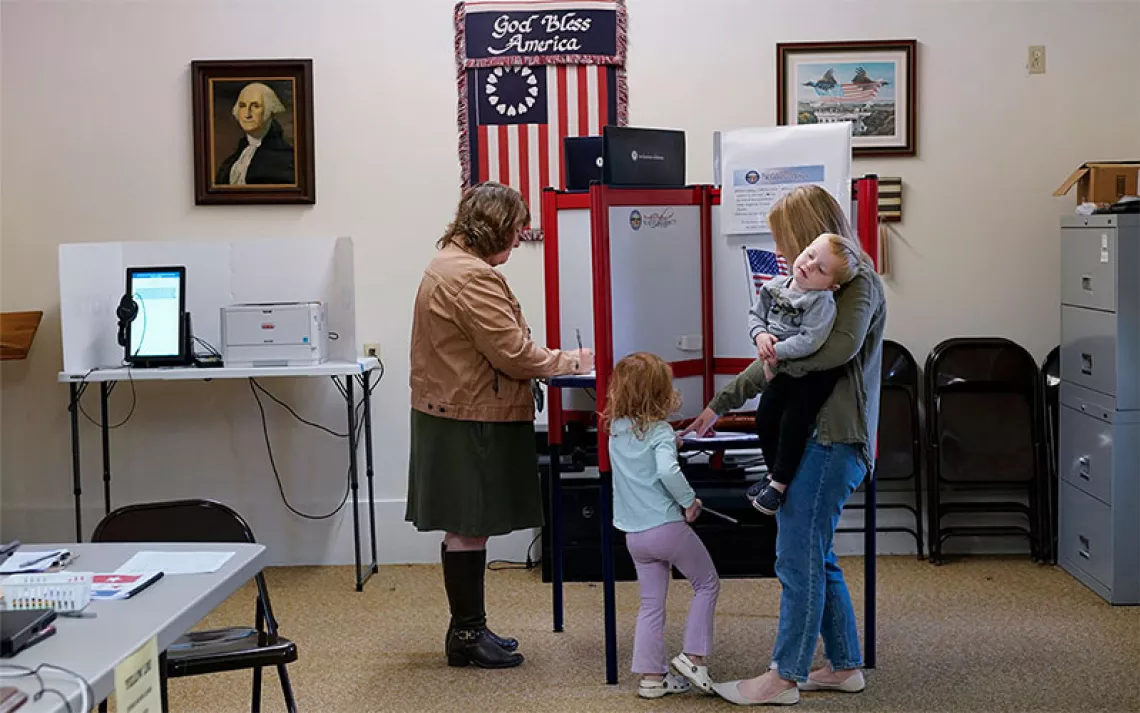What Do the Election Results Mean for Climate and the Environment?
Some quick takeaways from yesterday’s votes

Susie Lee, Democratic candidate for Nevada's third congressional district on November 7. | Photo by John Lecher/AP Photo
Progressives’ much-hoped-for blue tsunami ended up being more like a splash. The midterm elections delivered mixed messages, with Democrats reclaiming the House of Representatives in a rebuke to President Trump even as Republicans picked up several Senate seats. Some environmental champions triumphed. Others, for reasons having little to do with their environmental positions (hint: racism and voter suppression might have played a role), found themselves defeated. But from Maine to New Mexico and Nevada, new governors promise to serve as a bulwark against Trump’s most egregious environmental policies, though a raft of important climate and energy initiatives across the West flamed out.
Greens have a cause for a lot of optimism in the results of Tuesday’s vote. During a Wednesday morning press conference in Washington, D.C., leaders from some of the country’s most influential environmental groups said they were thrilled with the election outcomes.
“In the last two years, we’ve seen the most anti-environment president in history and most anti-environment Congress in history—and the voters said, ‘Enough,’” Gene Karpinksi, the president of the League of Conservation Voters, which put a record $80 million into elections nationwide, said. “The green firewall in the Senate is still intact. We have new leadershipn and a pro-environment majority in the House, and that’s a big step forward.… As we’ve said, if we’re going to make progress in the short term, it’s going to come from the states. And we have many, many new governors and statehouses that are committed to fighting for clean energy and action on climate.”
Here are some other take-aways from Tuesday’s election.
Governorships and Statehouses Pivot Progressive
The post-election headlines are focused on the end of one-party rule in Washington, but the bigger story may be the shift in governors’ mansions from Republican to Democrat.
During the first two years of the Trump presidency, governors like California’s Jerry Brown, David Ige of Hawaii, and Jay Inslee in Washington have been a vital counterforce to the White House’s retrograde climate policies. After Tuesday’s vote, the ranks of climate-action allies who are state executives has grown, as Democrats picked up at least seven governors offices.
In New Mexico, Michelle Lujan Grisham rolled to victory to become the first Latina elected governor; during her time in Congress, Lujan Grisham earned a 91 percent approval rating from the League of Conservation Voters. Maine’s extreme governor, Paul LePage, was replaced by Janet Mills, who as the state’s attorney general has challenged the lackadaiscial enforcement actions of Trump’s EPA. Michigan’s governor-elect, Gretchen Whitmer, has promised to remove the Enbridge Line 5 pipeline from underneath the Great Lakes and is committed to rebuilding her state’s aging water infrastructure. Whitmer, along with Illinois governor-elect J.B Pritzker, has promised to take her state to 100 percent renewable energy.
Colorado stayed in Democratic hands, but the governor-elect, Jared Polis, promises to be much more environmentally aggressive than his predecessor, John Hickelooper, who has made many compromises with the state’s oil and gas industry. During the race, Polis, a former U.S. representative from Boulder, distanced himself from an initiative to constrain oil and gas drilling (more on that later). But his long-term records prove him to be an environmental champion. Polis is also the first openly gay man to ever be elected governor.
These new state leaders will be crucial to help spearhead U.S. action on climate even as Trump remains latched to his fantasy that global warming will “change back.” In Oregon, Kate Brown has a big mandate (and a super majority in the statehouse) to put the Beaver State in the vanguard of climate and energy policy. It’s likely that some new states (Michigan, Maine, Wisconsin?) will decide to take on California’s strict auto emissions standards, bolstering the political fight against the Trump EPA’s attempted tailpipe rollbacks. In California, Gavin Newsom will be tested by grassroots greens to begin a managed sunsetting of the Golden State’s oil and gas industry.
Perhaps the biggest upset of the night was in Kansas, where Democratic state senator Laura Kelly bested conspiracy-minded vote-suppressor Kris Kobach. Kelly is unlikely to be an environmental champion; her prairie populism agenda has, understandably, other fish to fry after decades of Ayn Randian austerity. But at least she acknowledges that climate change is happening, and during her campaign she worked to create a new vernacular to talk about global warming with plains farmers and ranchers. Like former House speaker Tip O’Neill famously said, All politics is local.
Conservation-minded governors spread in a blue wall up and down the West Coast, across the southern Rockies and to the Lower Plains? Sounds pretty good.
The House Becomes a Co-Equal Branch of Government
The Republican monopoly on federal power is, at least for the next two years, over. As one NPR commentator said Tuesday night, “checks and balances polled very well” in exit interviews. Voters wanted a restraint on Trumpian overreach, and while environmental concerns probably played a small role in many voters’ motivation, lands, waters, wildlife, and climate will benefit from the change in House control.
“If we are going to be co-equal branches, that involves looking at the shrinkage of the monuments [Bears Ears and Grand Staircase–Escalante in Utah] and the rationale behind that,” Congressman Raul Grijalva, the Arizona Democrat who is poised to become the chair of the House Natural Resources Committee, told me on Monday afternoon. At the time, he was busy campaigning for Ann Kirkpatrick, who sailed to victory in Martha McSally’s old district, in Arizona-2. “Priorities would be the unfinished business of oversight and accountability.”
Read: Interior Secretary Ryan Zinke is in trouble. Already, the president is reportedly worried about Zinke’s shady real estate connections. A House committee with subpoena power will only make matters worse for Zinke, who could soon join the disgraced Scott Pruitt. (With Democratic leader Nancy Pelosi cautious that impeachment proceedings would be overreach, Democrats will likely go after smaller game.)
Grijalva also promises that his committee “will look one more time” at the Trump administration’s “extraction-only philosophy.” He says the House will try to reset relationships with “Indian Country and give it its space” while looking at how to create incentives for renewable energy projects on Native nations.
Some greens are hopeful that a Democratic House might advance bills like Hawaii Democrat Tulsi Gabbard’s legislation to put the United States on a 100 percent clean energy path. “There is chatter about a ‘Green New Deal,’ but it is pretty vague and hasn’t been fleshed out yet,” says RL Miller of Climate Hawks Vote, an eco political action committee. Miller says she’d like to see climate change “message bills” that would show what’s possible were Trump not in the White House.
That might be a long shot. But a Democratic House could achieve significant climate action gains through a sweeping infrastructure bill, which Pelosi has said is a priority and which could provide a transactional deal with Trump, who likes to think of himself as a builder. Done right, an infrastructure bill could be a climate bill that would underwrite EV infrastructure, transit, and high-speed rail. Bridge repairs would be funded; new roads would not. “Infrastructure” would also be defined to include seawall improvements, beach-nourishment programs, coastal wetland restoration. Environmentalists would also like for an infrastructure bill to include grid modernization, tougher clean energy standards for buildings, and building electrification. Sounds dreamy? Maybe. But the new chair of the House Transportation and Infrastructure Committee will be Peter DeFazio, a stalwart environmentalist who represents the emerald-green bastion of Eugene, Oregon.
House races obviously hinged on a number of factors, but environmentalists should note that some winning contests did center on climate concerns. Take Illinois-6, where a climate nerd, clean energy entrepreneur Sean Casten, defeated decade-long incumbent Peter Roskam. Or California-49, where environmental attorney Mike Levin snatched Darrell Issa’s seat. Look at California-48, where climate denier troglodyte Dana Rohrabacher is very likely to be dispatched by Democrat Harley Rouda. And in South Carolina, a political novice, Joe Cunningham, flipped a House seat held for decades by a Republican by running a campaign focused on his opposition to offshore oil drilling.
In the outer reaches of suburbia that have become the central battleground of U.S. politics, these kinds of candidates—white guys who’ve been successful selling clean energy—are evidently appealing candidates. Especially for techy millennials and security moms worried that their toddlers are going to grow up in a global dust bowl. And that, in its way, is a big step forward.
Big Money —> Oily Politics
Going into Tuesday, environmentalists were cautiously optimistic that a slate of climate and energy initiatives across the West would offer an encouraging referendum on climate and energy policy. Sorry to say, nearly all of the efforts flamed out.
In Arizona, Proposition 127, which would have required state utilities to get half of their power from renewables by 2030, became the most expensive initiative campaign in the history of the Grand Canyon State. The pro forces got shellacked 70-30. According to philanthropist Tom Steyer, whose NextGen America poured tens of millions of dollars into supporting the initiative, the defeat was due to shenanigans by Arizona’s attorney general, a recipient of donations from the state’s biggest utility, who rewrote the ballot language to make it sound less appealing. “This is an example of the corruption that besets our political system,” Steyer said during green groups’ Wednesday briefing. “What we say is that Americans in purple states support clean energy—as long as we are able to talk honestly about it, which we weren’t able to do.”
Colorado’s Proposition 112 would have required that oil and gas rigs maintain a 2,500-foot setback from homes and schools. It went down 56-43. Oil and gas firms and their employees put at least $40 million into the campaign to defeat the measure.
Washington State voters’ second attempt to put in place a statewide price on carbon, Initiative 1631, was a major disappointment. This time around, the initiative was better written, with everyone from the Sierra Club to Microsoft on board. But the fossil fuel energy companies poured $31 million into the campaign to beat it back. It sank by 13 points.
There was one bright spot: Voters in Nevada approved an initiative calling on the state's utilities to get 50 percent of their electricity from renewable sources by 2030.
Why wouldn’t Arizonans, of all people, want more solar power? Wouldn’t you want to keep fracking operations at least a half mile from your kids’ school? It’s hard not to see that the money makes the difference. At the end of election day, the Carbon Barons are even better capitalized than Tom Steyer.
The Climate Caucus Is, Unfortunately, Toast
The last Congress gave birth to a thing called the Climate Solutions Caucus, a bipartisan confab that was described, variously, as a heroic endeavor, greenwashing, and a political fig leaf for Republicans eager to show they sorta, kinda care about climate change. Even its best moments seemed quixotic. During a nonbinding July vote in the House about the idea of putting a price on carbon, only four of the 43 GOP members of the caucus could muster the political courage to vote for such commonsense climate action.
According to a head count by Politico, by the time new members of Congress are sworn in come January, half of the caucus’s Republican members will no longer be there. The departures include the caucus’s energizing force, Carlos Curbelo, a GOP representative from a district (Florida-26) that includes areas like the Florida Keys that are facing acute sea level rise. Whatever the caucus may have been good for in the past (and many greens say it wasn’t much), its future seems very much in doubt.
“Our hope at the Sierra Club is that the Climate Solutions Caucus will be replaced by something else,” Sierra Club executive director Michael Brune said during the Wednesday briefing. “Perhaps the Climate Action Caucus. Or the Climate Honesty Caucus.… Because what we need is stronger action, not just a few good speeches given throughout the year.”
For his part, Steyer expressed pessimism that there are any Republicans willing to take the climate change threat seriously. “If we want to succeed [in dramatically lowering greenhouse gas emissions] by 2030, it is completely unclear to me that there are Republicans who are willing to compromise,” he said. “This is a party that has decided there is no cost politically to lying about climate.”
Perhaps. But maybe Tuesday’s results will serve as a kind of wake-up call and force the GOP leadership to recognize that—especially in the suburban districts that have become the bellwether of U.S. politics—one can’t be a climate science know-nothing and still expect to be a viable candidate. That’s one outcome of the election that greens should hope for. Because it will take more than a single party, or one election, to save the planet.
 The Magazine of The Sierra Club
The Magazine of The Sierra Club



